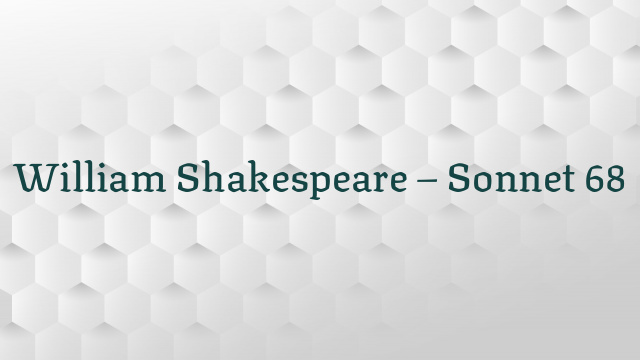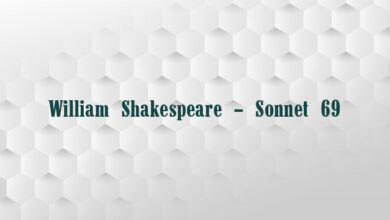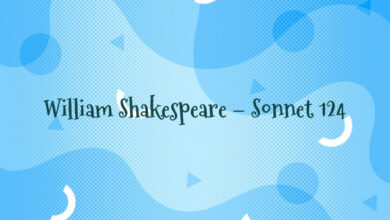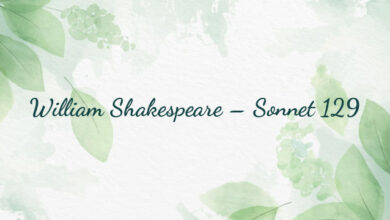
William Shakespeare – Sonnet 68
Thus is his cheek the map of days outworn,
When beauty lived and died as flowers do now,
Before these bastard signs of fair were born,
Or durst inhabit on a living brow;
Before the golden tresses of the dead,
The right of sepulchres, were shorn away,
To live a second life on second head;
Ere beauty’s dead fleece made another gay:
In him those holy antique hours are seen,
Without all ornament, itself and true,
Making no summer of another’s green,
Robbing no old to dress his beauty new;
And him as for a map doth Nature store,
To show false Art what beauty was of yore.
This sonnet and the previous one make a closely linked pair. They both inveigh against the artificiality of cosmetics, a theme which Shakespeare never seems to tire of. In his mind it was linked closely to deception, and to the threat that that posed to human relationships and to the social fabric in general.
… … … … There’s no art
To find the mind’s construction in the face
as Duncan observed in Mac.(I.4.11-12). It is folly to think that character is writ in the face. On the other hand, if one cannot trust appearances, what else may one trust?
Superficially the two sonnets present a criticism of cosmetics, deception, misrepresentation, or whatever, but they are swung round in favour of showing how beautiful the youth is compared with the hideousness of the age. One might suppose that this is not too controversial a topic. Yet there are serious obstacles in the way of an understanding of this group of sonnets (66-70). Not only are they difficult linguistically, but we lack the background knowledge to set them in a realistic historical context.
The two chief difficulties are that the attack on cosmetics is easily construed as a denigration of Elizabeth I, and that the pessimism of both this and the preceding sonnet, and the group as a whole, is out of tune with the age.
To deal with the first point first. We may note that, despite the fact that Elizabethan censorship of literature was not entirely complete or institutionalised, and rather haphazard in its application, (authors were punished after publication, rather than being constrained before the event, as in 19th. century Russia), a direct attack on the customs and practices of the monarch must have been dangerous. Yet here we have the practice of using the golden tresses of the dead to beautify one’s own scalp roundly censured, a practice which Elizabeth I was known to employ to good effect. When Essex burst into her chamber, after his return from a disastrous foray in Ireland, he found her without her customary wigs, looking very unglamorous in her thinning white old woman’s natural hair, and this was remarked on. It was well known that her beauty was no longer natural, but gallantry was encouraged and she enjoyed praise of her beauty, her figure, and her dancing.
We could take this censure of cosmetic adornment as being merely a part of the Puritannical tradition, which was fairly strong in post-Reformation England and Scotland at the time, reaching its full fruition in the time of the Commonwealth. But with Shakespeare’s closeness to the court through the presentation of his plays, and his links through his few published works to members of the nobility, it is difficult to see how he could lightly sanction such adverse comments against the times and, more specifically, against Elizabeth. We do not know how significant it is that the sonnets were not published until 1609, five years after Elizabeth’s death, since so little of Shakespeare’s work was published by him in his lifetime. It is always possible that in the mass of published matter and as a small part of a sequence of sonnets, a few adverse comments here and there would pass unnoticed. We assume that the lines in the Merchant of Venice quoted below (note to l.6) were not suppressed, even though they were critical of periwigs and hence of royal practice. So perhaps this was reckoned to be a not too dangerous area of politics, something touching a little the Queen’s vanity, but not a matter to which she would ever respond tyrannically.
In the commentary to the previous sonnet, I made the suggestion that the poet has possibly introduced a fictitious third party whose comments are contrary to the general tenor of the age. He is the speaker of 67 & 68 and somewhat extreme in his views, but he is evidently not the writer of the bulk of the sonnets, a point which he makes clear by referring to the youth in the third person. His conclusions are the same tedious repetition in each sonnet, and he adopts the pose of an old man who dislikes everything of today. His saving grace is that he admits the attraction of the youth and with an attempt at metaphysics tries to show why the youth strides forth from corruption. But apart from that all else is bad and irredeemable.
This is a plausible though unverifiable idea. It is after all difficult to assess how widespread the view was that the times were universally bad. Here is a comment on Elizabethan literature from the Oxford History of England (2nd. edition):
“……. the age of Elizabeth was an age of optimism, of experiment, of constructive achievement. The present was too full of interest for men of letters to fall back on the storehouse of memory, or to indulge in vain regrets for a vanished splendour. They looked forward not backward. They blazed fresh trails and opened up new channels of literary expression which subsequent generations turned into broad, beaten highways. Like pioneers, too, they fumbled and blundered; but their irrepressible exuberance and fertility of mind carried them through to amazing success.” J.B.Black, OHE, 1959-85.p.281.
Evidently this sonnet and several others do not chime with the above viewpoint, for they look far into the past, and they are exceedingly pessimistic. No doubt we now view the Elizabethan age with spectacles slightly rose tinted. In Victorian and earlier times it was more common to see Elizabeth herself as a vain and frivolous woman who toyed with a kingdom and was saved by the greatness of her loyal men of government and the devotion of her subjects. Now the pendulum has swung the other way and she is praised for her clear sightedness and moderation and because her clever policies (often simply policies of delay) allowed the country to flourish as never before. Yet there were substantial bodies of discontent within the land which were capable of making their voices heard. Often times which appear in retrospect to be a golden age are thought to be nothing of the sort by the contemporaries who are supposedly enjoying its prosperity.
Another possibility is that this group of sonnets were written when James I was king, after Elizabeth’s death in 1603. The bad times would then be the recent ones under James, and the golden age that which had ended with Elizabeth. This does seem unlikely, given the verbal echoes in this sonnet from the Merchant of Venice, which is usually dated around 1596/7. The bad times could perhaps be the time of the Essex rebellion, and of his downfall. He was a man who had much sympathy from the populace, and if Southampton is the beloved youth his involvement with Essex, although he was subsequently pardoned, would have made the times look very bleak. Essex was beheaded when he was only 33, while Elizabeth was 67, beautifying herself with wigs, making her summer of another’s green. These sonnets could therefore arise from the hostility felt by the writer to such a situation.
However I raise these possibilities more to emphasise what vast areas of unknown territory lie before anyone who undertakes a study of the sonnets, rather than to offer a solution. In the end one has to admit that the historical setting is unknown, the scope and application of the personal references can only hazily be guessed at, the level of satire or seriousness remains obscure, and the depth of involvement shifts as one gazes, like the refraction of images in water. Readers must judge for themselves how far they wish to enter the maze, for poetry has no limits, and the maze probably has no centre.
The 1609 Quarto Version

THus is his cheeke the map of daies out-worne,
When beauty liu’d and dy’ed as flowers do now,
Before thee baſtard ſignes of faire were borne,
Or durſt inhabit on a liuing brow:
Before the goulden treſſes of the dead,
The right of ſepulchers,were ſhorne away,
To liue a ſcond life on ſecond head,
Ere beauties dead fleece made another gay:
In him thoſe holy antique howers are ſeene,
Without all ornament,it ſelfe and true,
Making no ſummer of an others greene,
Robbing no ould to dreſſe his beauty new,
And him as for a map doth Nature ſtore,
To ſhew faulſe Art what beauty was of yore.
Commentary
1. Thus is his cheek the map of days outworn,cheek – stands here for the face. That the face could be seen as a map of personality was a popular Renaissance idea.
Ah, uncle Humphrey! in thy face I see
The map of honour, truth and loyalty 2H6.III.1.202-3.
days outworn = days long ago which are now abraded from memory. The youth is an image or record of past history, a golden age when things were more beautiful than in these bad times.2. When beauty lived and died as flowers do now,i.e. without external means of beautification, but with their own inherent splendour, as flowers live and die naturally.3. Before these bastard signs of fair were born,
bastard signs of fair = false, misleading means of beautifying one’s face or appearance; cosmetics.
bastard – (an adjective) because they were supplanting natural and legitimate beauty.
born = given birth to; worn (as clothing or adornments). More probably the latter, although the imputation of bastardy and illegitimacy points more to the former meaning. Shakespeare did not like the use of cosmetics, as they seemed to be the outward symbol of a false persona. The Puritan dislike of them was rooted more in an intense prejudice against frivolity of any kind. Cosmetics here includes not only face painting but other adornments also, such as wigs. They were bastard signs of fair in that they were not born with the person, but came into being as a subsequent birth alongside the individual they adorned, something born the wrong side of the blanket, as it were. Yet they were worn by the person, hence borne, or carried, by her/him. (Note Q’s spelling, borne).4. Or durst inhabit on a living brow;durst = dared to;
inhabit = occupy, place itself (on);
brow = forehead, head, face. Cosmetics would inhabit a face by dwelling on it, being placed on it.5. Before the golden tresses of the dead,
This is a reference to wigs being made from hair removed from corpses. Whether or not this was the chief source of hair used in wigs is uncertain. Presumably barbers would have supplied some of it. Golden was the desired colour for hair, but any shade approximating Elizabeth’s fading red hair was acceptable. The following is from a chapter on costume in Shakespeare’s England Oxford 1916, p.96.
“True golden hair was held in the highest estimation, but naturally all shades of auburn and red were favoured in a court whose Queen set the fashion by her own Tudor tresses, supplementing them as they faded with various wigs of these tints. … … … Women of fashion incurred much censure from the pulpit and scorn from the satirist for the general practice of dyeing their hair and wearing wigs. Face-painting was common among women and at court, and evidently was carried much farther than ever before. Harrison, Stubbes, Stow, Gosson, and other writers of the time see in it a token of a depraved mind, and imply that the use of face-paint is incompatible with moral behaviour.”
Cosmetics to enhance facial colour were used by men also in the Elizabethan period.6. The right of sepulchres, were shorn away,
The right of sepulchres – the hair of the dead should rightly be buried with them. A sepulchre is a tomb or burial place, a building, vault or excavation made for the internment of the dead. (OED 1.)
shorn away = cut off. Shakespeare’s pre-occupation with this subject may also be illustrated by the following from the Merchant of Venice:
… … … Look on beauty,
And you shall see ’tis purchased by the weight;
Which therein works a miracle in nature,
Making them lightest that wear most of it:
So are those crisped snaky golden locks
Which make such wanton gambols with the wind,
Upon supposed fairness, often known
To be the dowry of a second head,
The skull that bred them in the sepulchre. MV.III.2.88-96.
Other links to the sonnets from this scene of MV have already been noted. See especially Sonnet 37.
An old ballad which sings of the changing times under Queen Elizabeth tells of a flourishing gallant who came to this land:
With a new lady whose face is beautiful and fair,
Who never knew what belongs to housekeeping or care,
But purchased seven new fans to play with the air,
And seventy new dressings of other women’s hair;
From MS. Ashm. 38, fo. 113, (The Bodleian) quoted in Shakespeare’s England p.41 (see above). The seventy new wigs might well not be excessive in terms of the outlay of a fashionable lady. Queen Elizabeth probably had more.7. To live a second life on second head;
The vituperative homily against wigs continues. KDJ notes that Shakespeare’s interest in the matter might arise because he himself was a bald actor, and because he lived for a time in Silver Street, the home of the wig trade in London.8. Ere beauty’s dead fleece made another gay:fleece – perhaps suggested by shorn in line 6. The thought of lines 5-7 reiterated. There may also be a reference to the golden fleece of classical legend, a prize which tempted Jason and the Argonauts.9. In him those holy antique hours are seen,those holy antique hours – times of antiquity before the world was corrupt; the golden age.10. Without all ornament, itself and true,
A restatement of Platonic perfection, recalling line 8 of the previous sonnet. Although the antecedent of itself is doubtful, it probably refers to the youth. The thing itself is the unadorned and perfect creature. In King Lear’s eyes, (probably, but not certainly, written later than the sonnets) the naked Edgar was the epitome of the ‘true man’. Clothing and adornments obscure what is real and true. All that is missing in Lear’s raging tirade against hypocrisy is a reference to wigs.
Is man no more than this? Consider him well. Thou owest the worm no silk, the beast no hide, the sheep no wool, the cat no perfume. Ha! here’s three on ‘s are sophisticated! Thou art the thing itself: unaccommodated man is no more but such a poor bare, forked animal as thou art. KL.III.4.102-6.
SB thinks also that there may be a bawdy reference in all ornament to female pubic hair. Hence the line would also imply ‘you are more perfect than a woman’.11. Making no summer of another’s green,
Not adorning himself with the borrowed green and freshness of someone else’s growth and vigour.12. Robbing no old to dress his beauty new;
old = old tradition; older person (by taking their hair). The emphasis is on the youth’s freshness. He has nothing that is outworn or dead on him, no cosmetics and no other adornments.13. And him as for a map doth Nature store,Resuming the statement of line 1. The couplet is similar in its argument to the couplet of the previous sonnet:
O! him she stores, to show what wealth she had
In days long since, before these last so bad.
The homily against deception of the previous lines peters out into a conclusion that was foretold in line 1, with the addition that Nature has deliberately set aside the map of his face as a record in the ultimate hope of regenerating lost beauty from it as from a copy. store is used in the sense of keeping aside for improving the stock as in
Let those whom Nature hath not made for store, 11.
and in the previous sonnet:
O him she stores, to show what wealth she had 67
where the word is used in a similar sense.14. To show false Art what beauty was of yore.false Art = cosmetic painting; those who use it.
what beauty was of yore = what real beauty was like long ago (before these last times which have been so bad).




